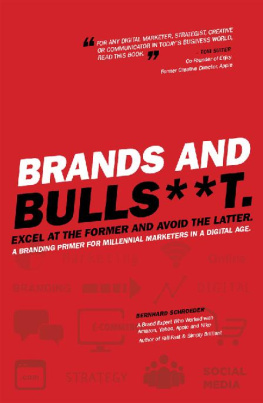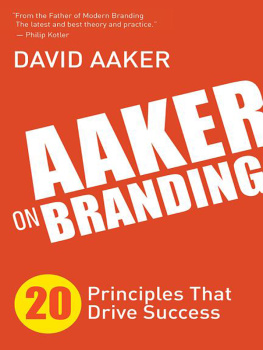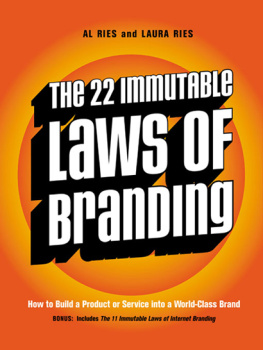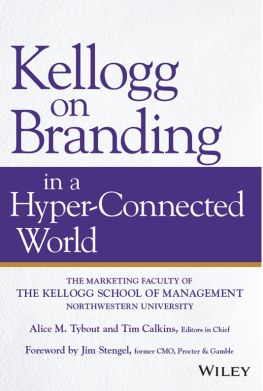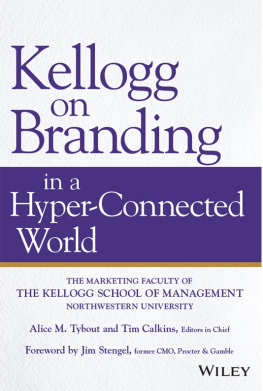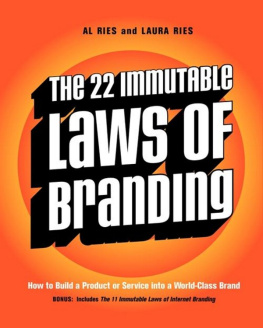ACKNOWLEDGM ENTS
Many individuals contributed to this book and warrant our thanks. It is impossible to mention everyone who helped, but a few people stand out.
This book is a product of the entire Kellogg School community. The faculty embraced the project and readily agreed to participate. Our executive contributors took time from their busy schedules to assemble thoughtful and insightful chapters. Kellogg School of Management Dean Dipak Jain was supportive of the project from the start. The marketing department administrative team provided invaluable assistance, as they do every day. James Ward and Subarna Ranjit deserve our special thanks. Judy Piper and Peggy Morrall kept the first Kellogg on Branding executive education programs on track. Perhaps most important, our students in the MBA and executive education programs gave us both insight and inspiration.
Several other people made invaluable contributions. Our editor at John Wiley & Sons, Richard Narramore, was supportive and encouraging throughout the project. Isidora Lagos at William Blair & Company, Dan Stone at the Alberto-Culver Company, and Kristina Hedley at Northwestern Memorial HealthCare all played critical roles in their respective chapters. Sally Saville Hodge provided valuable assistance on Chapter 12, Building a Brand-Driven Organization. Rebecca Lindell deserves a special thanks for her assistance with early drafts of the chapter on global branding.
The entire book benefited from the deft touch of Patty Dowd Schmitz, who reviewed and edited each chapter and provided invaluable feedback with directness and sensitivity.
Above all, we thank our families for their support and encouragement.
A.M.T.
T. C.
CHAPTER 1
BRAND POSITIONING
ALICE M. TYBOUT and BRIAN STERNTHAL
When TiVo launched its digital video recorder (DVR) system in 1999, the leading technology market research firm Forrester predicted, These hard-drive machines will take off faster than any other consumer electronics product has before. Forrester projected that there would be greater than 50 percent household penetration by 2005. They were optimistic because TiVo allowed viewers to store a library of shows tailored to their preferences, pause or rewind live TV, and quickly skip through commercials. In addition, TiVo was easy to program. In its initial advertising, TiVo announced that it would revolutionize television by empowering viewers to Watch what you want, when you want.
Although TiVo aficionados love it and recommend it with an almost evangelical zeal, sales have fallen far short of Forresters (and others) enthusiastic initial forecasts. As of January 2005, only 2.3 million households (slightly less than 2 percent) had TiVo. At the same time, the adoption rate of DVRs was increasing as cable companies began to embrace the technology and offer their own systems. But TiVos future remained uncertain. We contend that a critical factor in TiVos lackluster performance was the absence of a clear brand positioning.
Brand positioning refers to the specific, intended meaning for a brand in consumers minds. More precisely, a brands positioning articulates the goal that a consumer will achieve by using the brand and explains why it is superior to other means of accomplishing this goal. In the case of TiVo, the brand was positioned as empowering consumers, but how and why it accomplished this goal was never clear. Was TiVo like a VCR in allowing consumers to record programs for playback at a later time? If so, what made it a superior means of performing this function? If TiVo wasnt a better version of the VCR, then what was it and why was it uniquely empowering? Advertisements used to launch TiVo failed to answer these questions.
This chapter addresses the challenge of developing a strong brand positioning. We begin by outlining the key elements of a brands position. These include the goal that the customer can expect to achieve by using the brand (frame of reference) and an indication of why the brand is superior in achieving the goal (point of difference). This is followed by a more detailed assessment of how to select an appropriate customer goal, create a superiority claim, and orchestrate these elements to develop an effective position. We conclude by discussing how a brands positioning can be evolved over time.
POSITIONING FUNDAMENTALS
A statement of a brands position is typically developed by the brand manager. Ideally, it is grounded in insight about the goals and perceptions of a targeted group of consumers. Managers develop formal positioning statements to ensure a shared vision for the brand throughout the organization and to guide tactical thinking. Accordingly, a brand positioning statement may be distributed widely within the firm and even shared with the firms partners (i.e., advertising agency and retailers). Although the positioning may be written in consumer-friendly language, consumers are not expected to read the positioning statement. Rather, the consumer will see the end results of this positioning statementthe brand design, pricing, communications, and channels of distribution.
Formats and terminology for presenting a brands position vary by company, but certain components are generally viewed as critical:
A brief description of the targeted consumers in terms of some identifying characteristics, such as demographics and psychographics (activities, interests, opinions). These target characteristics are typically selected on the basis of category and brand usage.
A statement of the targets goal that will be served by consuming the brand, commonly referred to as the frame of reference.The frame of reference may guide the choice of targets, identify situations in which the brand might be used, and define relevant competitors (i.e., brands that claim to serve the same goal).
An assertion regarding why the brand is superior to alternatives in the frame of reference, referred to as the point of difference.
Supporting evidence for claims related to the frame of reference and point of difference, referred to as reasons to believe. This final element is more important when the claims are relatively abstract (credence claims) versus concrete (verifiable) because concrete claims often are their own reason to believe.
These items may be represented in a formal positioning statement. To illustrate, consider the following positioning statement for Black & Deckers DeWalt line of power tools:
To the tradesman who uses his power tools to make a living and cannot afford downtime on the job (target), DeWalt professional power tools (frame of reference) are more dependable than other brands of professional power tools (point of difference) because they are engineered to the brands historic high-quality standards and are backed by Black & Deckers extensive service network and guarantee to repair or replace any tool within 48 hours (reasons to believe).
The above positioning targets the tradesman and focuses on his goal of generating a reliable income by practicing his trade. DeWalt promises to help the tradesman achieve this goal more effectively than other brands of power tools by being more dependable. The essence of this positioning was captured in communications to the tradesman that promised No downtime with DeWalt.
If Black & Decker had instead wished to target the Do-It-Yourselfer (DIY), a different frame of reference and point of difference would have been necessary. Here, the goal might be to complete home repair projects in a professional manner, and DeWalt might claim superiority to other power tools in achieving that goal by noting that its tools are the tools of choice by the professional tradesman. This alternative approach is illustrated below.



